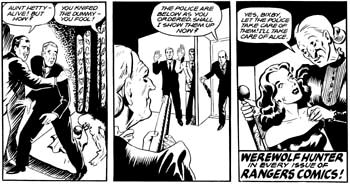![[Metroactive Books]](/books/gifs/books468.gif)
![[Metroactive Books]](/books/gifs/books468.gif)
[ Books Index | Metro | Metroactive Central | Archives ]
Women Wonders
Woman Warrior: Lily Renee's "Werewolf Hunter" from the "Rangers Comics" of the 1940s featured female characters--like fearsome Aunt Hetty--who wielded weapons and stopped criminals in their tracks.
A new book traces the long history of female cartoonists
YOU COULD CALL the noted San Francisco cartoonist Trina Robbins' A Century of Women Cartoonists (Kitchen Sink, $16.95) one hundred years in the making. The book includes a blurb by Susan Faludi, who claims that "the male-written history pages" have ignored women's accomplishments in the field.
Faludi's judgment is a bit much. Jerry Robinson's history The Comics (G.P. Putnam, 1974), for example, gives a better excerpt of Edwina Dumm's great comic strip Tippy than the one offered by Robbins. The bitter fact is that most of the cartoonists--male and female--from before 1960 are forgotten. So much the better for today's cartoonists; if the public knew how degraded the art is now, they'd rip the funny pages to shreds.
If Faludi misunderstands general neglect as the special problem of women, the sexism of the comics business can't be overstated. As Robbins notes, Wonder Woman herself wasn't drawn by a woman until 40 years after the Amazon made her debut. But A Century of Women Cartoonists doesn't just preserve the memory of artists overshadowed by greater (or, at least, maler) names but also provides a parallel history of American women over the century.
A Century of Woman Cartoonists covers images of Victorian mothers, flappers, WWII defense workers, '50s teens, consciousness-raised feminists and career women, the last as seen in Cathy Guisewite's ghastly daily strip, Cathy (Robbins' book doesn't end on that diminuendo note, fortunately).
The first women to do cartoons were the grandmothers of the Holly Hobbies and Strawberry Shortcakes of today. "The Queens of Cute," Robbins calls them. Louise Quarles' illustrated puns in 1901 were perhaps the earliest example of female cartooning. Rose O'Niell's cupidlike kewpies were stars of a popular comic strip before they were sickeningly sweet dolls.
Inevitably, the creator of such adorable adorableness had a Greenwich Village studio and a couple of divorces under her belt; Robbins repeats the tale that it was O'Niell's habit of talking in baby talk that may have contributed to the departure of her second husband. Grace Drayton was also noteworthy as the creator of the Campbell Soup Kids, round-faced urchins with such rosy highlights on their cheeks that they look as if they're sporting mutton-chop whiskers.
The once-celebrated Jazz Age cartoonist Nell Brinkley inaugurated a whole school of glamour art that women have penned from that day until this. Robbins really delved into ephemera here, bringing back a remarkable range of imagery of the 1920s new women--most of it cheesecakey narcissism, young beauties idling over the choice of men and the choice of clothes.
In this section, I wish Robbins could have underscored the story of Fay King. King was a cartoonist of modest talents. Still, in making herself a character in her own comic strip, King predated the wave of autobiographical comics that women pioneered 50 years later.
Northern California's own Dale Messick occupies a large place in Robbins' book. Messick's big-haired reporter character, Brenda Starr, made her creator the most popular of all women cartoonists for many decades. Messick drew not just a strong female hero but also an eccentric supporting cast as off-beat as the heavies in Chester Gould's Dick Tracy.
Messick is also, I believe, the only female cartoonist to have had a movie made from her work. Messick's long career bridges the world in which a woman cartoonist was a much-patronized novelty and the world of our time, in which one woman artist is the strongest talent in daily cartooning.
THOUGH ROBBINS isn't one to play favorites, I am. To the quick scan, Lynn Johnston's For Better or for Worse is a thicket of muppetlike faces, round noses and falling leaves. Regular attendance, however, reveals the serious work Johnston puts into her comic strip.
Johnston is gifted at transcribing the dialect of children, but she isn't a queen of cute; the kids in the strip are often a little mucky, as likely to do something really odd as really sweet. And the parents are often besieged; the mother, Ellie, slumps a little under the burden of dealing with them.
Who else in comics has written not just with affection but such seriousness about being a mother, and who else has had Johnston's real courage? In 1993, Johnston decided to have one of her characters, Lawrence, come out of the closet. Almost 20 newspapers canceled Johnston's strip, but 56 more, lured by the controversy, picked it up, adding to her run of 1,730 newspapers nationwide.
Robbins' lovingly researched book is filled with stories of sexual discrimination, careers that ended and headed into obscurity--in one case, there's the wistful caption "The author knows nothing about the creator of this delightful strip."
And cartooning is still mostly a boys' club. Still, the history of a century of women cartoonists ends optimistically, with women at last recognized for their place in the history of a lively art.
[ Metro | Metroactive Central | Archives ]
This page was designed and created by the Boulevards team.

Lily Renée
From the May 1-7, 1997 issue of Metro